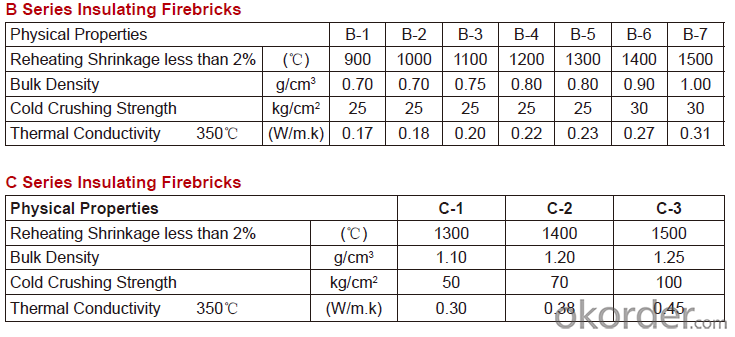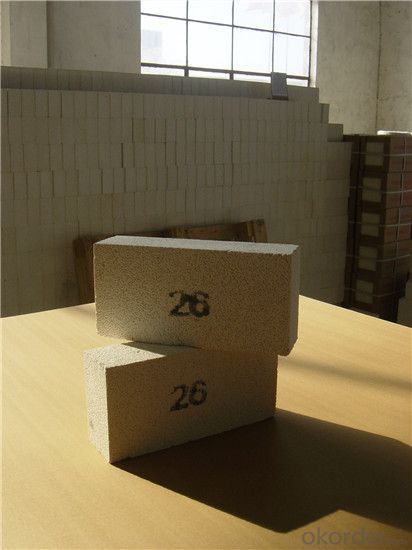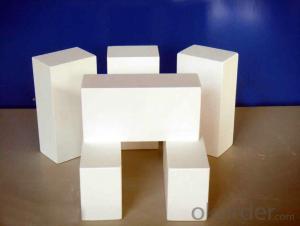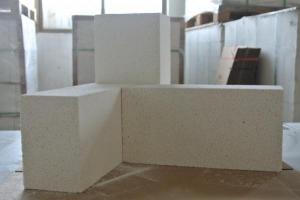Insulating Fire Brick for Coke Ovens - Thermal Insulation Fire Clay Brick
- Loading Port:
- Shanghai
- Payment Terms:
- TT OR LC
- Min Order Qty:
- 1 m.t.
- Supply Capability:
- 1000 m.t./month
OKorder Service Pledge
OKorder Financial Service
You Might Also Like
Thermal Insulation Fire Clay Brick
Refractory brick is a block of refractory ceramic material used in lining furnaces, kilns, fireboxes, and fireplaces.
We provide high quality Refractory Fire Bricks that are used on wide range in the various industries like Cement, Glass and Steel. Refractory Fire Bricks are provided as per the quantity and specifications required by the customers. We provide an extensive range of Refractory Fire Bricks at reasonable prices that depend upon the quantity ordered.
Application
Insulating Fire Brick are used for the lining of converter, alternating current arc furnace, direct Current arc furnace and the ladle slag line, etc.
Company Advantage
(1)Long Insulating Fire Brick manufacture history: 25 years manufacturer
(2)Advanced equipment
(3)Diversification of production standards: ISO ANSI FEPA JIS ASTM
(4)Flexible payment: T/T L/C D/P D/A
(5)Professional marketing team and after-sale service
Insulating Fire Brick main feature:


Equipment
1 unit of Ceramic Abrasive (SG Abrasive) pilot production line
2 units of Compact grain Abrasive pilot production lines
1 unit of high-end coated abrasives (abrasive cloth) production line
2 units of Boron Carbide production lines
3 large flexible crushing and sieving lines for grit production lines
6 units of 5000KVA-10000KVA dumping type electric arc furnaces for Brown Fused Alumina fusion
Q1 What’s the transport method?
A1 FCL delivery goods with wooden pallet or wooden case by sea; If LCL delivery, must with wooden case; Sometimes need open top, flat rack or bulk cargo.
Q2 What’s the required payment term?
A2 Generally 30% TT as the prepayment, 70% TT before delivery. If need, 100% Irrevocable Letter of Credit or negotiation.
Q3 Which country are our products exported to?
A3 Apart from entire Chinese market, the US, Russia, Japan, Korea, Australia and some Southeast Asian Nations.


- Q: Can insulating fire bricks be installed in both industrial and residential settings?
- Yes, insulating fire bricks can be installed in both industrial and residential settings. These bricks are designed to withstand high temperatures and provide excellent insulation, making them suitable for applications in furnaces, kilns, fireplaces, and other heating systems found in both industrial and residential environments.
- Q: Do insulating fire bricks require any special insulation blankets or jackets?
- Insulating fire bricks (IFBs) possess exceptional insulating properties, rendering them generally exempt from the need for specialized insulation blankets or jackets. However, in certain circumstances and environments, supplementary insulation may prove necessary. In cases where IFBs are subjected to high temperatures or extreme thermal conditions, the utilization of insulation blankets or jackets can prove advantageous, augmenting insulation capabilities and safeguarding against damage. These supplementary insulation materials serve to diminish heat loss, heighten energy efficiency, and prolong the lifespan of IFBs. Consequently, although not invariably essential, it is worthwhile contemplating the implementation of insulation blankets or jackets in specific scenarios to optimize the performance of insulating fire bricks.
- Q: Is it possible to paint or coat insulating fire bricks?
- Yes, it is possible to paint or coat insulating fire bricks. However, it is important to use heat-resistant paints or coatings that can withstand high temperatures. Regular paints or coatings may not be suitable as they can crack or peel due to the intense heat. It is recommended to consult with a professional or refer to the manufacturer's guidelines to ensure the correct type of paint or coating is used for insulating fire bricks.
- Q: Can insulating fire bricks be used in high-temperature insulation blankets?
- No, insulating fire bricks cannot be used in high-temperature insulation blankets. Insulating fire bricks are solid and dense bricks made of refractory materials that are designed to provide excellent thermal insulation and structural support in high-temperature applications such as furnaces and kilns. On the other hand, high-temperature insulation blankets are flexible and lightweight blankets made of ceramic fibers or other refractory materials that are specifically designed for insulation purposes. These blankets are able to withstand extremely high temperatures while providing excellent thermal insulation. Therefore, the two products serve different purposes and cannot be used interchangeably.
- Q: Are insulating fire bricks suitable for insulation in heat treatment furnaces?
- Yes, insulating fire bricks are suitable for insulation in heat treatment furnaces. These bricks are specifically designed to withstand high temperatures and provide excellent thermal insulation. They have a low thermal conductivity, which helps to minimize heat loss and maintain a stable temperature inside the furnace. Insulating fire bricks are also lightweight, making them easier to handle and install. Additionally, they have good resistance to thermal shock, meaning they can withstand rapid changes in temperature without cracking or breaking. Overall, insulating fire bricks are a reliable and effective choice for insulation in heat treatment furnaces.
- Q: Can insulating fire bricks be used in the construction of foundry molds?
- Yes, insulating fire bricks can be used in the construction of foundry molds. Insulating fire bricks are designed to withstand high temperatures and provide excellent thermal insulation properties, which make them suitable for use in foundry molds. These bricks help to maintain a consistent temperature within the mold, ensuring efficient and effective casting processes.
- Q: Can insulating fire bricks be used in cement kilns?
- Indeed, in cement kilns, insulating fire bricks find their utility. These bricks are specifically engineered with a low thermal conductivity, rendering them an excellent choice for insulating environments that endure high temperatures, like cement kilns. By employing these bricks, heat loss can be minimized, thereby enhancing energy efficiency within the kiln. Furthermore, their lightweight composition facilitates ease of handling and installation in the kiln. Nevertheless, it is crucial to carefully select insulating fire bricks that align with the unique operating conditions and demands of the cement kiln to guarantee utmost performance and durability.
- Q: Can insulating fire bricks be used in the construction of combustion chambers for rocket engines?
- Yes, insulating fire bricks can be used in the construction of combustion chambers for rocket engines. Insulating fire bricks are designed to withstand high temperatures and provide excellent insulation, making them suitable for use in the extreme conditions of rocket engine combustion chambers. Their ability to retain heat while minimizing heat transfer to the surrounding structure is crucial for ensuring efficient and safe operation of the engine.
- Q: Can insulating fire bricks be used in incinerators?
- Indeed, insulating fire bricks can be utilized in incinerators. These bricks are specifically crafted to offer exceptional thermal insulation, rendering them perfect for scenarios where elevated temperatures must be sustained. By incorporating insulating fire bricks into incinerators, which function at exceedingly high temperatures, heat loss can be minimized and the system's overall energy efficiency can be enhanced. Furthermore, these bricks possess commendable resistance against thermal shock, a critical characteristic in incinerators subject to sudden temperature fluctuations. Consequently, the utilization of insulating fire bricks in incinerators can significantly augment their performance and durability.
- Q: Can insulating fire bricks be used as a thermal barrier?
- Yes, insulating fire bricks can be used as a thermal barrier. These bricks have high thermal resistance and low thermal conductivity, making them effective in reducing heat transfer. They are commonly used in applications where thermal insulation is required, such as in furnaces, kilns, and fireplaces, to prevent heat loss and protect surrounding areas from excessive heat.
Send your message to us
Insulating Fire Brick for Coke Ovens - Thermal Insulation Fire Clay Brick
- Loading Port:
- Shanghai
- Payment Terms:
- TT OR LC
- Min Order Qty:
- 1 m.t.
- Supply Capability:
- 1000 m.t./month
OKorder Service Pledge
OKorder Financial Service
Similar products
Hot products
Hot Searches
Related keywords






























